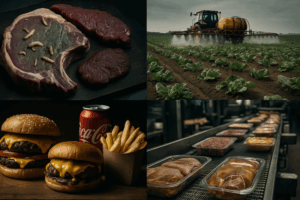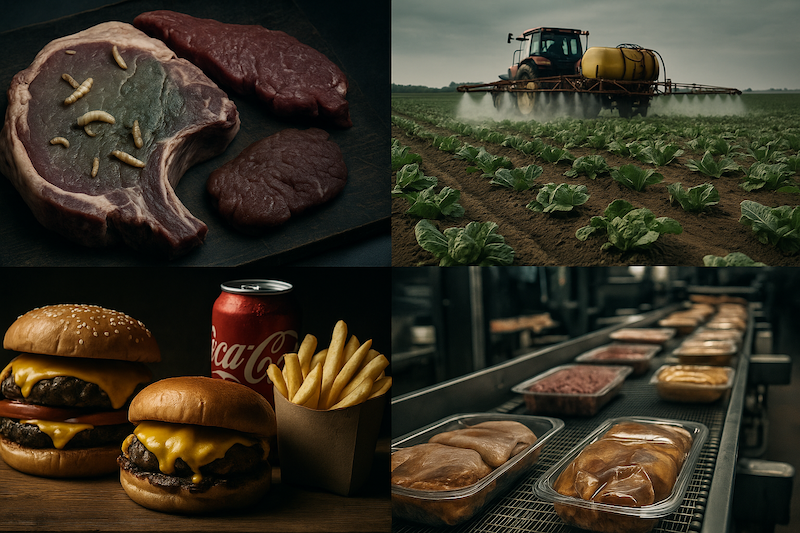You think you know what you’re eating. You don’t.
Every day, millions of people trust that the food on their plates is exactly what the label says it is. But behind the glossy packaging and reassuring brand names lies a darker reality: an industry riddled with contamination, fraud, and cover-ups that have killed thousands and sickened millions more.
From babies poisoned by tainted formula to families unknowingly eating horse instead of beef, these food safety disasters have exposed the shocking vulnerabilities in our global food supply chain. The worst part? Many of these scandals were preventable, and some companies knew about the problems for years before taking action.
Here are 10 of the most shocking food scandals in history that forever changed what—and how—we eat.
1. The Chinese Melamine Milk Scandal (2008): When Baby Formula Became Poison
The Crime: In 2008, Chinese dairy producers deliberately added melamine—an industrial chemical used in plastics—to infant formula to fake higher protein content after diluting milk with water.
The Damage: This wasn’t just a food safety failure. It was mass poisoning. Over 300,000 babies were affected, 54,000 were hospitalized, and six infants died from kidney stones and kidney failure. The scandal didn’t stop at China’s borders—contaminated products reached shelves in 68 countries worldwide.
What Changed: The melamine scandal triggered a complete loss of consumer confidence in Chinese dairy products. To this day, Chinese parents travel to Hong Kong and overseas to buy foreign infant formula rather than trust domestic brands. The incident led to stricter international food safety protocols, trade restrictions, and the execution of several individuals involved in the fraud.
Why It Matters: This scandal proved that economically motivated adulteration could happen on a massive, coordinated scale—and that babies were considered acceptable collateral damage in the pursuit of profit.
2. The UK Horsemeat Scandal (2013): Your Beef Wasn’t Beef
The Crime: In 2013, Irish food safety inspectors made a disturbing discovery: beef products across Europe contained up to 100% horsemeat. What started as routine testing uncovered a sophisticated international food fraud network.
The Damage: Millions of “beef” products were recalled across Europe. Major retailers including Tesco, Asda, and countless others found horsemeat in their lasagnas, burgers, and other products. Tesco’s market value dropped by €360 million. But the real damage was to consumer trust—people realized they had no idea what they were actually eating.
What Changed: The scandal exposed the dangerous complexity of global food supply chains. A single contaminated batch could travel through multiple countries and companies before reaching your dinner table. The Elliott Review commissioned by the UK government led to the creation of the National Food Crime Unit and introduced the “8 pillars of food integrity” framework now used worldwide.
Why It Matters: This wasn’t about health—horsemeat isn’t inherently unsafe. It was about systematic deception. If fraudsters could swap horse for beef on this scale without anyone noticing, what else are we eating without knowing?
3. Jack in the Box E. coli Outbreak (1993): The Burger That Killed Four Children
The Crime: Jack in the Box served undercooked beef patties contaminated with E. coli O157:H7, a deadly bacterial strain.
The Damage: Over 700 people fell ill, primarily in the Pacific Northwest. Four children died, and 178 others were left with permanent injuries including brain damage and kidney failure. The youngest victim was just two years old.
What Changed: This tragedy fundamentally transformed how America handles food safety. The FDA raised the required cooking temperature for ground beef from 140°F to 155°F (eventually 160°F). It sparked the creation of modern HACCP (Hazard Analysis and Critical Control Points) systems that restaurants and food processors must follow today.
Why It Matters: Before Jack in the Box, E. coli was relatively unknown to the public. This outbreak put foodborne pathogens on the national radar and proved that major restaurant chains could serve potentially lethal food—and did.
4. Blue Bell Ice Cream Listeria Outbreak (2015): Comfort Food Turned Deadly
The Crime: Blue Bell Creameries’ ice cream products were contaminated with Listeria monocytogenes bacteria found throughout their manufacturing facilities.
The Damage: Ten people were hospitalized, three died, and Blue Bell had to recall every single product from the market—a complete shutdown. The Texas-based company that had been a beloved regional institution for over 100 years had to halt all production.
What Changed: This scandal showed that even family-owned, “trusted” brands with strong reputations could harbor deadly contamination. Blue Bell spent millions upgrading facilities and implementing new safety procedures. The outbreak led to increased scrutiny of ice cream and frozen dessert manufacturing nationwide.
Why It Matters: Listeria is particularly dangerous for pregnant women, the elderly, and those with weakened immune systems. The idea that ice cream—a treat associated with childhood and comfort—could kill was a wake-up call about pathogen risks in unexpected places.
5. Jensen Farms Cantaloupe Listeria (2011): The Deadliest Outbreak in Modern History
The Crime: Jensen Farms in Colorado sold cantaloupes contaminated with Listeria due to dirty water and old, filthy equipment in their packing facility.
The Damage: This was the deadliest foodborne illness outbreak in modern U.S. history. 147 people fell ill across 28 states, 33 died, and pregnant women suffered miscarriages. The contamination spread through fruit processing companies, affecting cut fruit products nationwide.
What Changed: The Jensen brothers were criminally charged and convicted—a rare outcome in food safety cases. They received probation, home detention, $150,000 fines each, and 100 hours of community service. Jensen Farms declared bankruptcy and shut down. The tragedy led to sweeping new regulations and mandatory safety audits for fresh produce operations.
Why It Matters: Fresh produce was previously seen as a low-risk food category. This outbreak shattered that assumption and revealed how seemingly “healthy” foods could harbor deadly pathogens.
6. ConAgra Peanut Butter Salmonella (2007): Profits Over People
The Crime: ConAgra’s Peter Pan peanut butter, manufactured in Sylvester, Georgia, was contaminated with Salmonella. The company later admitted their products had tested positive for Salmonella in the past—yet they continued shipping.
The Damage: Over 600 people across nearly every U.S. state were poisoned. Three years’ worth of peanut butter had to be recalled, affecting Peter Pan, Great Value (Walmart’s brand), and even toppings at Sonic and Carvel.
What Changed: ConAgra paid $11.2 million in fines—then the highest-ever fine for a food safety case—plus $36 million in civil settlements. They spent $275 million on plant upgrades. Company officials blamed a leaking roof and malfunctioning sprinkler, but the real scandal was their continued production despite knowing about contamination.
Why It Matters: This exposed how companies will prioritize profits over safety, continuing to sell products they know are contaminated. ConAgra continues to struggle with recalls to this day.
7. The 2006 Spinach E. coli Crisis: When “Healthy” Food Became Hazardous
The Crime: Fresh spinach from California’s Salinas Valley was contaminated with E. coli O157:H7, likely from contaminated irrigation water or animal feces.
The Damage: 205 people confirmed infected across 26 states and Canada, 102 hospitalizations, 31 cases of severe kidney failure, and three deaths. The majority of victims were women. The spinach industry lost an estimated $74 million in sales.
What Changed: The FDA issued an unprecedented warning telling consumers to avoid all fresh spinach from the region. This outbreak fundamentally changed how fresh vegetables are grown, washed, and distributed. It led to the Food Safety Modernization Act and new produce safety regulations.
Why It Matters: This proved that “natural” and “healthy” don’t mean safe. The contamination highlighted vulnerabilities in fresh produce farming and distribution that consumers never considered.
8. Sara Lee Hot Dogs Listeria (1998-1999): The Hidden Killer in Your Lunch
The Crime: Sara Lee’s Bil Mar brand hot dogs and deli meats were contaminated with Listeria monocytogenes. Inspectors later cited roaches and unsanitary conditions in the Michigan plant.
The Damage: At least 80 illnesses, 15 deaths, and six miscarriages across 11 states. The contamination went undetected for months between August 1998 and January 1999.
What Changed: Sara Lee Corporation pled guilty to misdemeanor charges and paid $4.4 million in fines, research funding, and lawsuit settlements. The outbreak led to stricter regulations on ready-to-eat meats and increased awareness that Listeria could survive and grow even in refrigerated conditions.
Why It Matters: Hot dogs and deli meats are convenience foods eaten by millions daily. This outbreak showed that everyday lunch staples could harbor deadly bacteria, especially dangerous for pregnant women.
9. The 1982 Alaskan Salmon Botulism Scare: 60 Million Cans Recalled
The Crime: Canned Alaskan salmon was contaminated with Clostridium botulinum (botulism) through small punctures in cans caused by faulty manufacturing equipment.
The Damage: Two deaths—a 27-year-old Belgian man and a 68-year-old Connecticut woman who was left paralyzed before dying. Nine Alaskan canneries recalled approximately 60 million cans of salmon manufactured in 1980 and 1981. Sales of Alaskan canned salmon ceased worldwide.
What Changed: This became the second-largest canned food recall in U.S. history. It led to complete overhauls of canning equipment and inspection protocols. Botulism, while rare, can be fatal, making any contamination catastrophic.
Why It Matters: Botulism in canned foods was thought to be a problem of the past. This outbreak proved that modern manufacturing could still produce deadly products through equipment failures.
10. Odwalla Apple Juice E. coli (1996): When “Natural” Meant Dangerous
The Crime: Odwalla’s unpasteurized apple juice was contaminated with E. coli O157:H7. Company executives later admitted they didn’t realize E. coli could survive in acidic juice.
The Damage: One 16-month-old child died, dozens more became seriously ill. The company’s stock plummeted and losses exceeded $12 million, not including lawsuits and a $1.5 million federal fine.
What Changed: Odwalla immediately began pasteurizing all its juice products. The outbreak led to increased regulation of the fruit juice industry, which had previously been largely self-regulated. It shattered the myth that “natural” and “unpasteurized” meant better or safer.
Why It Matters: This scandal revealed the dangers of food industry trends marketing “natural” products without proper safety measures. Parents learned that unpasteurized juices marketed as healthy alternatives could kill their children.
The Uncomfortable Truth About Your Food
These 10 scandals represent just the tip of a massive iceberg. Hundreds of food recalls happen every year, most of which you never hear about. The reality is that our food supply chain—stretched across continents and involving countless middlemen—is vulnerable to contamination, fraud, and corporate negligence.
What You Can Do to Protect Yourself
1. Stay informed: Sign up for FDA recall alerts and check recall lists regularly.
2. Cook thoroughly: Proper cooking temperatures kill most dangerous bacteria. Use a food thermometer—don’t guess.
3. Know your sources: The shorter the supply chain, the easier it is to trace problems. Buy local when possible.
4. Read labels carefully: Check for country of origin, processing locations, and certifications.
5. Trust your instincts: If food looks, smells, or tastes wrong, throw it out. No product is worth risking your health.
6. Demand accountability: When companies prioritize profits over safety, consumers have the power to demand change through purchasing decisions and public pressure.
The Bottom Line
The food industry has repeatedly proven it cannot self-regulate effectively. From melamine in baby formula to horse in your lasagna, these scandals share common themes: corporate greed, inadequate oversight, complex supply chains, and delayed action that cost lives.
These aren’t just cautionary tales from the past—food fraud and contamination continue today. In 2025, new recalls are issued almost weekly. The question isn’t whether another major scandal will happen, but when.
The next time you pick up a product at the grocery store, remember: trust but verify. Because when it comes to your food, ignorance definitely isn’t bliss.

